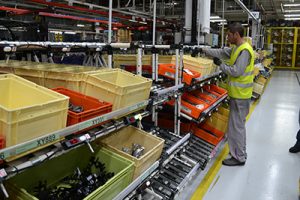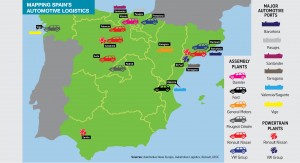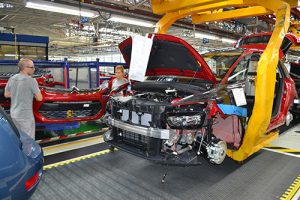 Spain’s production and sales are recovering from a long period of decline, with growth also in the country’s supplier base. Our four-part report looks at how manufacturers are responding.
Spain’s production and sales are recovering from a long period of decline, with growth also in the country’s supplier base. Our four-part report looks at how manufacturers are responding.
Reporting and contribution by Anthony Coia, Christopher Ludwig and Roger Stansfield.
After more than five years of multiple recessions, fiscal austerity, high unemployment and a bailout from the European Union, Spain’s automotive industry has emerged as an unlikely success story. It has solidified its place as Europe’s second largest vehicle producer behind Germany; according to ANFAC, the Spanish automotive association, total vehicle assembly was up more than 12% in the first ten months of 2015 compared to 2014, at nearly 2.3m units, of which 1.9m were exported. The country is likely to finish 2015 with more than 2.6m units in production, compared to 1.9m in 2012, and the most since 2007.
In the last few years, following a mix of government reform and agreements with labour unions, major carmakers in the country have invested billions of euros in their Spanish production and supply chain networks. Renault Nissan, for example, is using its Spanish plants to build vehicles on the Alliance’s most successful platforms, including the new Renault Mégane and Kadjar in Palencia, northern Spain; Seat’s plant in Martorell, 40km north-west of Barcelona, has increased production not only for its namesake brand, but for Audi as well. General Motors, PSA Peugeot Citroën and Ford have expanded Spanish production even as they closed other factories in western Europe.
A mix of economic recovery and government support has also fuelled growth in sales following one of Europe’s sharpest declines. Spain’s light vehicle sales fell from 1.9m units in 2007 to just 775,000 in 2012, the year it received a European bailout. However, sales have risen at double-digit annual growth rates over the past two years. In the first ten months of 2015, passenger car registrations, at 864,000, were up more than 20% compared to 2014, while commercial vehicles were up by 35% to 126,000, according to ACEA, the European carmaker’s association.
In this story
Other stories in this featureThe rise in output has led to growth in the Spanish supplier base, for which OEMs such as PSA, Renault and GM are all trying to increase sourcing, as well as optimising flows to their plants with the use of milkruns and other advanced logistics processes. Seat, together with its Volkswagen Group parent, has also been investing in technology and hardware, such as RFID and paperless check-in processes for trucks.
3PLs such as Ceva and Gefco have increased their assets and transport fleets. Likewise, a number of Spanish ports, including Barcelona, Vigo and Pasajes, have invested in improved handling, berths and rail-loading facilities.
However, Spain’s growth does not come without risks, including the chance of further economic or political shocks. While its logistics network is well developed, some executives point to high costs and fees, especially for energy. José Manual Machado, the president of Ford Spain, even recently warned an audience at a KPMG meeting that high costs, including for logistics, could eventually lead OEMs to pullback from Spain.
Pacts for supply chain progressFollowing Spain’s bailout and subsequent reforms, carmakers signed agreements with unions that restrained salaries and made labour practices more flexible. “The Spanish OEMs have made considerable efforts to become more competitive by reaching salary agreements with local unions based on productivity and higher working-hour flexibility, to adapt to the high production volume volatility imposed by the different European countries’ peak sales seasonality,” says Bjørn Svenningsen, head of sales and marketing at short-sea shipping provider, UECC.
In response, carmakers have invested heavily in Spain. Ford has invested €2.3 billion ($2.45 billion) in Valencia, where production is expected to rise from 283,000 units in 2014 to around 400,000 in 2015, and up to 450,000 by 2016. At Palencia, which has received most of Renault’s €600m investment in Spain, production will rise from 133,700 in 2014 to around 300,000 in 2016. At GM’s Opel plant in Zaragoza, in the north-east, production rose 14% year-on-year in 2014 to 319,586 units with the introduction of the Opel Mokka; the carmaker planned 360,000 units in 2015, with further increases planned when it starts building PSA vehicles at the plant. At PSA’s plant in Vigo, assembly is expected to grow from around 380,000 in 2014 to 500,000 units by 2018.

These rises are increasing logistics services and the need for engineering across supply chains. Ceva Logistics, for example, carries out in-plant logistics for Renault in Spain. Marco Galbusera, managing director for Ceva in Iberia, points to the need for more in-factory solutions to support the production line. Along with warehousing, these include picking, subassembly and kitting – especially as Renault is substantially increasing kitting at Palencia.
Volume increases and the need for flexibility provide opportunities to open new buffer warehouses near the factory, he adds, and implement milkruns. Ceva opened a buffer warehouse in Valencia in early 2015 and increased its capacity during the summer. It opened another this past summer in Valladolid, where Renault also has assembly and engine plants.
“For spare parts, we have also opened new warehouses for high-demand items near the main dealers to reduce lead time,” says Galbusera.
Carmakers in Spain are putting more emphasis on engineering intermodal solutions into their inbound logistics, as well as improved milkrun routes. PSA’s Vigo plant receives about 700 inbound trucks daily, and has three warehouses located inside the plant that are adjacent to production areas. José Luis Alonso Mosquera, director for production coordination and logistics at Vigo, says that with production now expected to increase, PSA has been targeting lower logistics and total landed costs in Spain, including by improving routing between suppliers and incorporating more multimodal routes. Currently, about 90% of Vigo’s inbound material arrives by truck and about 10% by ocean.
Other carmakers already use rail and intermodal for a higher proportion of inbound transport. Seat uses road for 80.3% of its volume, rail for 19.4%, while the small remainder moves by sea, says logistics manager Enric Marti. Truckloads are prepared mainly through crossdocking activities across different supplier clusters. Marti says that inbound logistics processes are integrated fully within the Volkswagen Group’s European network, benefitting from corresponding volume and load balance synergies. However, he sees room for improvement. “We are aiming to reduce cost by increasing load saturation, the use of optimal designed containers, and the increase of intermodality,” he says.
The carmaker recently increased intermodal flows by implementing a truck-rail concept for inbound material flow from Germany, which Marti says is more stable, reducing the need for urgent transport by more than 50%, thus helping to avoid supply breaks.
 Click to enlarge
Click to enlargeLocal and global connectionsSpain has a strong and competitive local supply chain, with carmakers typically sourcing a majority of parts within Spain. At Renault’s Palencia plant, for example, 70-80% of parts are sourced within the country. At PSA, Alonso says 75% of parts are of Spanish origin. Seat is also highly localised in Spain.
Despite this, increasing parts localisation and supply planning are targets among Spain’s OEMs. At PSA, Alonso has been working on developing supplier groupings in Spain; in particular, he wants closer synchronisation between suppliers and PSA’s production and total supply chain costs. “These challenges imply a rising trend towards greater competition between our supply chain teams. The simultaneous development of supplier groupings, such as the Galician automotive suppliers cluster, plays an important role in the overall flow optimisation of our supply chain,” he says.
Seat has also been trying to source more parts in the Iberian Peninsula in an effort to reduce logistics costs and increase flexibility. “We are committed to increasing the amount of locally produced parts. This has enabled us to optimise our transportation costs by reducing distances,” says Marti. “It has also made it possible for us to put more contemporary supply concepts into practice, such as direct delivery and just-in-sequence shipping.”
He also points to benefits such as being able to respond quicker to changes in supply sources, production line blockages, or emergencies.
However, since all of Spain’s car production plants are part of foreign global companies, their connections to international supply chains are important as well. For new models introduced at Ford Valencia, almost half of all the accompanying new suppliers were from the US and Asia. For the new Mégane and the Kadjar in Palencia, Renault shares parts both from France and Asia, as well as from Nissan production in Sunderland, in the north of England. At Vigo, 15% of PSA parts come from France, 7% from Portugal, and 3% from other countries.
 "The simultaneous development of supplier groupings, such as the Galician automotive suppliers cluster, plays an important role in the overall flow optimisation of our supply chain"
"The simultaneous development of supplier groupings, such as the Galician automotive suppliers cluster, plays an important role in the overall flow optimisation of our supply chain"
- José Luis Alonso Mosquera, PSA Vigo
In Zaragoza, GM is a special case with the localisation of the Mokka crossover SUV, which GM shifted from South Korea to Spain for European customers. GM builds about 85,000 Mokkas per year, for which it uses many South Korean suppliers, according to Guillermo Mancholas, supply chain and logistics director at GM Spain. Some 60% of the Mokka’s inbound materials is imported to the plant, amounting to more than 10,000 40ft sea containers per year, says Mancholas, most of it sent through the port of Barcelona.
Across all of its production in Zaragoza, GM imports about 40% of material from outside Spain, including important links to the rest of Europe; for example, it imports engines and powertrain parts to Spain from other Opel plants in central Europe by rail. Road links are also essential for the carmaker for both local Spanish suppliers (54% of GM’s purchase value in Spain comes from within 300km), as well for European content.
Lluis Paris, commercial manager at the port of Barcelona, says the port has seen a sharp rise in imported automotive parts. “As Spain’s car-building cluster consolidates, we are experiencing a steady increase in imported parts. Noteworthy is the logistics chain implemented by GM and Gefco to bring parts for the Opel Mokka from South Korea to Zaragoza,” says Paris. “Exports are also thriving for both parts and CKD kits.”
Export expansionWith exports set to approach 2.3m vehicles in 2015, vehicle logistics operations across Spain and its ports are growing. From Vigo, for example, PSA ships 1,700 vehicles daily, of which 82% move by ocean vessel, 14% by truck, and 4% by rail. The plant builds vehicles for 68 countries worldwide, with France its largest importer, receiving 22% of Vigo’s total production. The port of Vigo was Spain’s second largest for new vehicle trade in 2014, handling nearly 420,000 units.
Gefco, which handles PSA and GM’s logistics in Spain, among others, has substantial vehicle logistics operations in the country, including yards at Pinto, near Madrid, Porriño, and the port of Vigo; it has another two facilities in Barcelona, as well as ones at Vitoria and Valencia ports. These yards are for storage, workshop activities and rail logistics according to Julian Navarro, director general of Gefco Spain.
Already with a truck fleet of more than 200 car carriers, Gefco Spain is targeting further asset investments, including adding more trucks and rail wagons, to improve control over service levels and costs, says Navarro, especially with a notable shortage of transport capacity in Spain. “By maintaining these resources ourselves, we could achieve some improvements in capacity, have better lead times through mixed loads, and hold down price trends through competition,” he says.
 Gefco's major clients in Spain include PSA's plants as well GM
Gefco's major clients in Spain include PSA's plants as well GMGefco already invested in rail wagons for Spain in 2014 to relieve capacity shortages, and an increase in its truck fleet helped restrain price rises when contracting with other providers. Gefco plans to maintain and grow fleet volumes in line with the Spanish market, says Navarro.
Spain’s ports have also been expanding their vehicle-handling capacity. At Barcelona, which handled Spain’s largest new vehicle volume in 2014, finished vehicle exports are growing to East Asia, the Americas, and western Europe, according to Lluis Paris. Furthermore, imports have risen by 40%, particularly from Asia. The port has also seen a rise in Mexican imports from Mazda’s new plant in Salamanca.
Barcelona port has also been improving its infrastructure. It has added berths and now has a total of four deep-sea and three feeder berths. At its Costa Pier, the port has implemented new operational systems for rail that enable the movement of more trains per day. According to Paris, delivery and pick up times have improved, as have rail management and quality, allowing shorter operational times at every terminal. The port has also fitted every gate with OCR readers, which can convert documents such as PDFs, barcodes and paper into searchable data, helping to track and improve truck movements. Furthermore, the port has installed new active and passive RFID readers.
Other Spanish ports have also grown. UECC runs a ro-ro service that calls at the Spanish ports of Pasajes, Santander, Vigo, Málaga, Sagunto and Tarragona, while operating its own terminal in Pasajes, and in Vigo in a joint venture with the Bergé Group. According to Bjørn Svenningsen, Spanish ports have rapidly adapted to growing volumes by developing more marshalling areas, multi-storey garages, railway and road access infrastructures. Svenningsen also credits ports with simplifying bureaucracy, thanks in part to a move towards a single-window customs declaration system.
UECC’s primary growth is at ports located on the north Spanish coast, including Vigo, Santander, and Pasajes. “We have increased our sailing frequency and capacity with more and larger vessels of 1,500-3,000-car capacity,” says Svenningsen. “The lead time has been reduced significantly and thereby reduced inventory cost for our customers.”
Hope and riskSpain’s growth is not without its risks. Local demand has been spurred by a government incentive scheme, and sales may yet slip after the programme is withdrawn. Likewise, years of recession, unemployment and austerity mean the economy is still weak, and could stumble. Spain’s highly export-focused production is also dependent on sales growth in other markets, such as the UK and France.
More broadly, Spain faces some political uncertainties; national elections in December saw the ruling conservative Popular party won the most votes but lost its overall majority, with a large share of votes going to two new populist parties. At the time of writing the shape of a new coalition government is unclear. Meanwhile, this past autumn, Catalonia, Spain's richest area, voted for independence in a regional plebiscite, which the central government in Madrid is resisting.
For logistics, plenty of challenges remain. The imbalance between imports and exports still creates uneven flows, for example. The Iberian Peninsula also uses a different rail gauge than most of Europe, making efficient long-distance connections difficult. “We are lobbying the Spanish government to have a wider standard [European] UIC rail network in Spain,” says Lluis Paris. “We believe that the UIC connection from the port of Barcelona to the French border is not enough to create proper synergies with vehicle assembly plants in our area. We expect trains to and from Europe to be able to call these plants in order to take advantage of supplementary volumes.”
 "The objective is to enable the introduction of innovative solutions such as Big Data, RFID, ‘quick check in’, and geofencing"
"The objective is to enable the introduction of innovative solutions such as Big Data, RFID, ‘quick check in’, and geofencing"
- Enric Marti, Seat
However, advances in processes and technology are helping Spain. Investments by Renault and Ford have brought higher levels of automation in assembly and parts handling, while others have invested in new IT systems, including Ceva. “We have invested in a new Matrix Mobile technology application that has improved the quality of our ground services along with control and real-time visibility for every shipment,” says Marco Galbusera. “This has led to a 20% reduction in claims and an increase in on-time delivery of 2%.”
Enric Marti wants to update Seat’s inbound processes with mobile systems. The OEM is experimenting with technology that other Volkswagen Group plants have applied, such as paperless truck check-in and geofencing. The Martorell plant has also taken a lead in RFID. “Primarily, we use a programme of production process improvement called PQT (Productivity, Quality, and Team), in which different logistics optimisation tools are integrated,” he says. “The objective is to enable the introduction of innovative solutions such as Big Data, RFID, ‘quick check in’, and geofencing.”
With other carmakers also making advances (see Renault and GM), there is more hope in Spain’s future than might have been imagined just a few years ago.



































